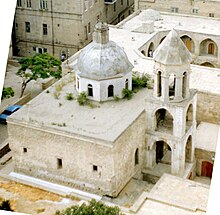Church of the Holy Mother of God (Baku)

The Church of the Holy Mother of God ( Armenian Սուրբ Աստվածածին եկեղեցի , Russian Церковь Святой Богоматери, церковь Аствацацин , Azerbaijani Surp Astvatsatsin Erməni Kilsəsi ) was an Armenian Apostolic Church in the Old Town (İçərişəhər) from Baku ( Azerbaijan ) from the 18th century, in 1992 was demolished. It was located on the south side of the Jungfrau tower on a curve of Neftjanik Prospect ( "Oil Workers Avenue" Проспект Нефтяников, Neftçilər Prospekti ) between caravanserai (today Mugam Club Baku until 1996 Music Museum), Barbara Street (Варваринская улица, from 1939 Wiaczesław- Mienżynski Street Улица Вячеслава Менжинского, since 1992 Həqiqət Rzayeva küçəsi ) and the Great Minaret Street, named after Asaf Zeynally since 1939 (Большеслава Менжинского Минаретская Минаретская Минаретская Минаретская .
Since there were few Armenians in the old town compared to the rest of Baku , the church only had a small congregation. Because of this, and because her memory was erased from the collective memory in Baku, little is known about her and some statements about her are contradictory. According to Leonid Semjonowitsch Bretanitzki , the church was built next to an Armenian caravanserai under the Maiden's Tower . Benjamin Arustamjan claims that Hamdallah Mustaufi (approx. 1281-1344) may have already mentioned a church in Baku and that a church of the Holy Mother of God (Surp Astvatsatsin) in 1799 - under the Persian rule of the Qajars - at the foot of the Maiden Tower within the Baku fortress was built and destroyed in the 1930s. However, the church was still standing until the Nagorno-Karabakh conflict , as can be seen in several photos. In contrast, the Armenian Cathedral of St. Thaddäus and Bartholomäus was actually demolished in Baku under Josef Stalin .
At the end of the 19th century, the Armenian priest Markar Barchudarjanz established that the Armenians in Baku had two stone churches: the large church of Gregory the Illuminator and the small church of the Holy Mother of God, which he described as particularly old, as well as the inner and external forms of architecture are recognizable.
Thomas de Waal cites the eyewitness account of a diplomat working in Baku in 1992, who observed the destruction of the church at the height of the Nagorno-Karabakh conflict. An open space remained on the former church site at the Jungfrauenturm.
Individual evidence
- ↑ a b c d Thomas de Waal: Black Garden - Armenia and Azerbaijan Through Peace and War. New York University Press, 2003. ISBN 0-8147-1944-9 , p. 103.
- ↑ Леонид Семёнович Бретаницкий: Баку - архитектурно-художественные памятники. Издательство «Искусство», 1970, p. 86.
- ↑ Вениамин Арустамян: Город утраченный - город утративший. Об истории бакинской армянской общины. Армянский Вестник 1–2. Издательство «Гуманитарий», 1999, p. 52.
- ↑ Армянский Собор во имя Св. апостолов Фаддея и Варфоломея - Будаговский собор (Баку). Наш Баку - История Баку и бакинцев, October 20, 2017.
- ↑ Մակար Բարխուտարեանց, Աղվանից երկիր և դրացիք, Թիֆլիս (Tbilisi), 1893, p. 153.
Coordinates: 40 ° 21 ′ 57 ″ N , 49 ° 50 ′ 13 ″ E
